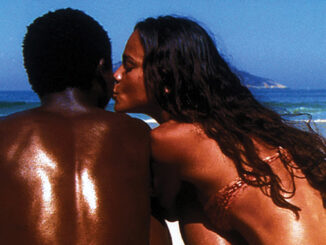
“In your own work, of which films are you most proud? Which scenes?”
Folmar Blangsted: A Star is Born: the first “Rhapsody in Blue” sequence; the dressing room confession of Judy Garland to Charles Bickford. Camelot: Arthur and Guinevere’s goodbye. Summer of ‘42: the lovemaking. Rio Bravo: the first and last reels.
John Maurice Bloom: Georgy Girl: This was a case where there was potentially interesting material, but there was a total lack of form. This had to be created in the editing process.
Margaret Booth: Mutiny on the Bounty, Camille: They hold up. Bombshell: At the time it seemed a mediocre film; it was a failure. It was a very fast-edited film, maybe too fast for most people. But the buffs liked it.
Claudine Bouché: I am prouder of films that were weak in the state of rushes and which, after a lot of work in the cutting room, were big successes! Allow me to keep their names secret!
Donn Cambern: I chose “favorite moments” rather than films or scenes. Easy Rider: the campfire scene when Jack Nicholson talks about visitors from outer space; a cut is made to Dennis Hopper, stoned, looking at Nicholson as if he is insane. Steelyard Blues: the cut to a naked fanny during the titles. The Last Picture Show: scene in the pool hall with Cybill Shepherd and Clu Gulager; the look when she realizes—and accepts—the situation. The scene following between Shepherd and Ellen Burstyn. The scene between Burstyn and Timothy Bottoms after the elopement is thwarted; Burstyn looks at Bottoms as they ride back together, sizes him up, then decides against it. Blume in Love: Nina and Blume are having tea; she cries, a sudden signal to their problems. Cinderella Liberty: the birth of the baby. The Hindenburg: final scene. Alex and the Gypsy: Alex eating chicken, the girl behind him; the moment when she reveals both her love and the unbridgeable gap between them. The scene where Alex pushes Krainpool “out of the nest.”
“I hesitate to name films of which I am most proud. There are some to which I could point that were box-office failures, but which I like to think my contribution may have made at least releasable.” – William Reynolds
Jim Clark: None. An impossible decision to weigh one film against another. If pushed, I’d single out: The Innocents, Charadeand certain parts of Midnight Cowboy to which I contributed. The finale of Day of the Locust also pleases me when I see it.
Francoise Collin: Pierrot Le Fou.
Henri Colpi: As editor: L’Opera Boeuf; Nuit et Brouillard; Le Mystere Picasso; Hiroshima, Mon Amour; L’Annee Derniere a Marienbad.
Rudi Fehr: Key Largo. Humoresque. Watch on the Rhine: I was especially pleased with Watch on the Rhine. The director had never made a film before and I worked with him day and night to lay out the shots.
Antony Gibbs: Petulia. Tom Jones: the eating scene, which I assembled one Sunday morning and never touched again except to remove three feet of tricky one-frame intercuts at the very end.
Agnes Guillemot: Une Femme est une Femme: for the interplay of words and music as in an opera. Les Carabinieres: for the crescendo of the postcard sequence.
Anthony Harvey: Dr. Strangelove; The Spy Who Came in from the Cold; The L-Shaped Room; Dutchman.
William Hornbeck: A Place in the Sun: I must say I was very proud of my part, especially the treatment of long dissolves, which for a time became very popular. Giant; Shane: I thought the fight scenes in Giant and Shane were quite effective in their day.
Ralph Kemplen: Moulin Rouge: the opening sequence. A Man for all Seasons: the scene between Orson Welles and Paul Scofield, because of the mountain of material that had to be selected and woven together. The Day of the Jackal: the sequence where the Jackal sets the sights on his gun, because of the economy of its cutting; the final section leading up to his death.
“There was potentially interesting material, but there was a total lack of form. This had to be created in the editing process.” – John Maurice Bloom
Harold Kress: Random Harvest: where Greer Garson is trying to stimulate Ronald Coleman’s amnesia-affected memory. The Yearling: the boy-deer sequences. Mrs. Miniver: when the German soldier comes to the old lady’s house and demands food at gunpoint.
Rennee Claude Lichtig: Impressions de New York; Les Fils de L’eau; The Wedding March (1954, music and effects score); La Grande Illusion (1959, international music and effects track); Le Testament du Docteur Cordelier; Le Dejeuner sur l’herbe; Le Caporal epingle; King of Kings: the sequence of Christ’s Sermon on the mount. Volcan Interdit; In the French Style: Kamouraska; Les Corps Celestes; Un Meurtre est un Meutre; La Main a Couper.
Daniel Mandell: Wuthering Heights; Pride of the Yankees: Gehrig day in Yankee Stadium. The Best Years of Our Lives: wedding scene.
Reginald Mills: Stairway to Heaven; The Red Shoes; The Servant; Romeo and Juliet.
Robert R. Parrish: Body and Soul: the prizefight at the end. All the King’s Men: Willy Stark’s rise.
William Reynolds: I hesitate to name films of which I am most proud. There are some to which I could point that were box-office failures, but which I like to think my contribution may have made at least releasable. Those are instances of which only I and others immediately involved can be aware. Apart from them, I think I look back with particular pride to: Compulsion; Bus Stop; Fanny; The Sound of Music; The Sand Pebbles; The Sting; The Great Waldo Pepper. Not because of editorial achievement but because everything else came together too—direction, acting, music, sound—to make outstanding films.
“I am prouder of films that were weak in the state of rushes and which, after a lot of work in the cutting room, were big successes!” – Claudine Bouché
Ralph Rosenblum: A Thousand Clowns; The Night They Raided Minsky’s: first reel. Goodbye Columbus: from the wedding to the end of the film.
John Victor-Smith: Help!: “Ticket to Ride.” The Three Musketeers: the sword fight where D’Artagnan helps the Three Musketeers against the Cardinal’s guards. Robin and Marian: the final duel between Robin and the Sheriff.
Ernest Walter: Shoes of the Fisherman; Nicholas and Alexandra; Inn of the Sixth Happiness: Perhaps this one most of all as it was relatively early in my editing career. All scenes with Robert Donat were extremely difficult. The poor man was dying in real life as well as in the story. His performance had to be extracted line by line from a mass of takes. One was forced to edit against one’s desires and instincts purely to keep his performance, as the dying mandarin, flowing.
Elmo Williams: High Noon; They Won’t Believe Me; Gun for a Town; The Vikings; The Longest Day; Those Magnificent Men in Their Flying Machines. These films afforded me the freedom to add creative ideas to the process of editing.
To help us celebrate the 70th anniversary of the Motion Picture Editors Guild, our colleagues at the prestigious film journal Film Comment in New York have allowed us to reprint copy from their special 24-page section celebrating film editors––“Prime Cut”––which appeared in the March-April 1977 issue. While the bulk of their salute was a semi-exhaustive list of filmographies of the top 75 editors (Film Comment’s selection) from the United States, Great Britain and France, we decided to forego that element, since it only covered up to 1977––and besides, those credits are readily available today on IMDb. We retained their 75 choices, however, as well as other parts of their section: editors’ answers to questions about editing techniques and their best work, and an interview with Robert Wise about cutting Citizen Kane.
So, beginning above and continuing in the articles “Top 75 Picture Editors“, “Prime Cut“, “Film Editors Forum” and “As the Editor, You’re the Audience” , everything––save for some photos, captions and headlines––is the work of the Film Comment team from 1977. Special thanks to our writer Kevin Lewis and especially Film Comment’s Sayre Maxfield (who is still with the publication today) for making all of this happen. – The Editor





